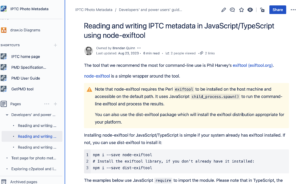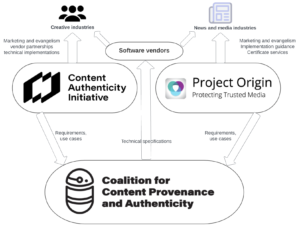Categories
Archives

We at IPTC receive many requests for help and advice regarding editing embedded photo and video metadata, and this has only increased with the recent news about the IPTC Digital Source Type property being used to identify content created by a generative AI engine.
In response, we have created some guidance: Developers’ and power users’ guide to reading and writing IPTC Photo Metadata
This takes the form of a wiki, so that it can be easily maintained and extended with more information and examples.
In its initial form, the documentation focuses on:
- Using the ExifTool command-line tool to read and write IPTC Photo Metadata,. ExifTool is commonly used by developers and power users to explore embedded metadata;
- Reading and writing image metadata in Python using the pyexiftool module;
- Reading and writing metadata in JavaScript (or TypeScript) using the node-exiftool module.
In each guide, we advise on how to read and create DigitalSourceType metadata for generative AI images, and also how to read and write the Creator, Credit Line, Web Statement of Rights and Licensor information that is currently used by Google image search to expose copyright information alongside search results.

We hope that these guides will help to demystify image metadata and encourage more developers to include more metadata in their image editing and publishing workflows.
We will add more guidance over the coming months in more programming languages, libraries and frameworks. Of particular interest are guides to reading and writing IPTC Photo Metadata in PHP, C and Rust.
Contributions and feedback are welcome. Please contact us if you are interested in contributing.

The IPTC is proud to announce that after intense work by most of its Working Groups, we have published version 1.0 of our guidelines document: Expressing Trust and Credibility Information in IPTC Standards.
The culmination of a large amount of work over the past several years across many of IPTC’s Working Groups, the document represents a guide for news providers as to how to express signals of trust known as “Trust Indicators” into their content.
Trust Indicators are ways that news organisations can signal to their readers and viewers that they should be considered as trustworthy publishers of news content. For example, one Trust Indicator is a news outlet’s corrections policy. If the news outlet provides (and follows) a clear guideline regarding when and how it updates its news content.
The IPTC guideline does not define these trust indicators: they were taken from existing work by other groups, mainly the Journalism Trust Initiative (an initiative from Reporters Sans Frontières / Reporters Without Borders) and The Trust Project (a non-profit founded by Sally Lehrman of UC Santa Cruz).
The first part of the guideline document shows how trust indicators created by these standards can be embedded into IPTC-formatted news content, using IPTC’s NewsML-G2 and ninjs standards which are both widely used for storing and distributing news content.
The second part of the IPTC guidelines document describes how cryptographically verifiable metadata can be added to media content. This metadata may express trust indicators but also more traditional metadata such as copyright, licensing, description and accessibility information. This can be achieved using the C2PA specification, which implements the requirements of the news industry via Project Origin and of the wider creative industry via the Content Authenticity Initiative. The IPTC guidelines show how both IPTC Photo Metadata and IPTC Video Metadata Hub metadata can be included in a cryptographically signed “assertion”
We expect these guidelines to evolve as trust and credibility standards and specifications change, particularly in light of recent developments in signalling content created by generative AI engines. We welcome feedback and will be happy to make changes and clarifications based on recommendations.
The IPTC sends its thanks to all IPTC Working Groups that were involved in creating the guidelines, and to all organisations who created the trust indicators and the frameworks upon which this work is based.
Feedback can be shared using the IPTC Contact Us form.